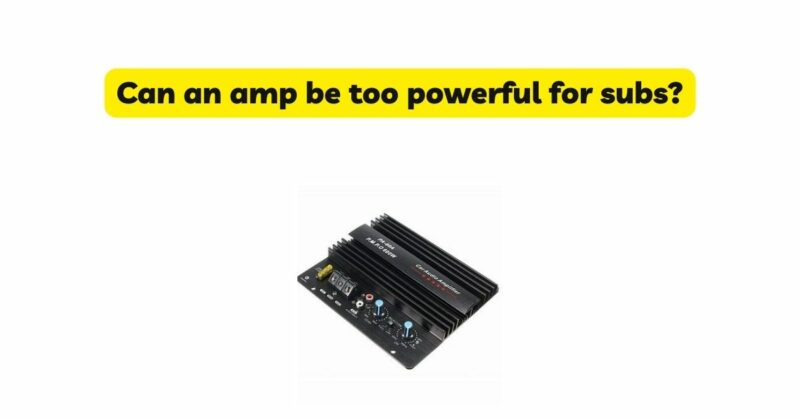Subwoofers are essential components in audio systems, responsible for reproducing low-frequency sounds and delivering impactful bass. When it comes to pairing an amplifier with subwoofers, it is important to strike the right balance between power output and the capabilities of the subwoofers themselves. In this article, we will explore the potential effects and considerations when an amplifier is too powerful for subwoofers, helping you understand the implications and make informed decisions for your audio setup.
Understanding Subwoofer Power Handling: Subwoofers are designed with specific power handling capabilities, which indicate the amount of power they can handle without distortion or damage. This power handling is typically measured in terms of RMS (Root Mean Square) power, representing the continuous power the subwoofer can handle. It is important to match the power output of the amplifier to the power requirements of the subwoofers to ensure optimal performance and protect the equipment.
Effects of an Overpowered Amplifier on Subwoofers:
- Distortion and Damage: Using an amplifier that is too powerful for the subwoofers can lead to distortion and potential damage. When an amplifier delivers excessive power to the subwoofers, it pushes them beyond their limits, causing the speaker components to strain and potentially fail. This can result in distorted bass output, reduced sound quality, and even physical damage to the subwoofers.
- Loss of Control and Accuracy: An overpowered amplifier can also lead to a loss of control and accuracy in bass reproduction. Subwoofers require precise control over the movement of their drivers to accurately reproduce low-frequency sounds. When the amplifier provides more power than the subwoofers can handle, it can cause the drivers to move excessively, resulting in loose, boomy, and imprecise bass response. This can diminish the overall audio quality and impact the clarity and definition of the bass.
- Reduced Longevity: Operating subwoofers with an overpowered amplifier can significantly reduce their lifespan. The excessive power demands can put a strain on the subwoofer’s components, such as the voice coil and cone, causing them to heat up and wear out more quickly. This can lead to premature failure and the need for more frequent replacements or repairs.
Considerations for Matching Amplifier Power to Subwoofers:
- Power Ratings and Specifications: Carefully examine the power handling capabilities and specifications of your subwoofers, including their RMS power rating, impedance, and sensitivity. It is crucial to choose an amplifier that closely matches or slightly exceeds the power requirements of the subwoofers, ensuring that they can handle the amplified signal without being overdriven.
- RMS vs. Peak Power: Pay attention to the difference between RMS power and peak power ratings. RMS power represents the continuous power handling capacity, while peak power refers to the maximum short-term power that the subwoofer can handle. It is generally recommended to focus on the RMS power rating when matching the amplifier to the subwoofers for consistent and reliable performance.
- Crossover and Gain Settings: Properly configuring the crossover and gain settings on the amplifier is crucial for achieving optimal integration between the amplifier and the subwoofers. Adjust the crossover point to ensure that the subwoofers receive the appropriate frequency range and avoid sending excessive power to frequencies they cannot effectively reproduce. Similarly, setting the gain control appropriately helps prevent overpowering the subwoofers.
- Room Size and Acoustics: Consider the size and acoustics of your listening environment. Larger rooms may require more power to adequately fill the space and provide sufficient bass presence. Additionally, room characteristics such as reflections and resonances can impact bass response. Understanding the room’s acoustics will help in selecting an amplifier that complements the subwoofers’ capabilities for optimal performance.
Conclusion: Matching the power output of the amplifier to the power handling capabilities of the subwoofers is crucial for achieving optimal bass performance and protecting your equipment. Using an amplifier that is too powerful for the subwoofers can lead to distortion, loss of control, reduced longevity, and potential damage. By considering the specifications of the subwoofers, configuring the amplifier settings correctly, and accounting for room size and acoustics, you can ensure a well-balanced audio system that delivers impressive bass reproduction without compromising the integrity of your subwoofers.


